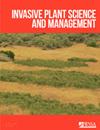Refining tree size and dose–response functions for control of invasive Pinus contorta
IF 1.2
4区 生物学
Q3 PLANT SCIENCES
引用次数: 3
Abstract
Abstract Exotic conifers are rapidly spreading in many regions of New Zealand, as well as in many other countries, with detrimental impacts on both natural ecosystems and some productive sector environments. Herbicides, in particular the active ingredient triclopyr, are an important tool to manage invasive conifers, yet there is a paucity of information that quantifies the amount of herbicide required to kill trees of different sizes when applied as a basal bark treatment. Two sequential experiments were conducted to define the amount of triclopyr required to kill individual invasive lodgepole pine (Pinus contorta Douglas ex Loudon), trees of different sizes when applied in a methylated seed oil to bark (either the whole stem or base of the tree) and to determine which tree size variates (height, diameter at breast height [DBH], crown diameter [CD]) or derived attributes (crown area, crown volume index) best characterized this dose–response relationship. The outcomes of the dose–response research were compared with field operations where triclopyr was applied to the bark of trees from an aerial platform. Applying the herbicide to the whole stem, as opposed to the base of the tree only, significantly increased treatment efficacy. The tree size variates DBH, CD, crown area, and crown volume index all provided good fits to the tree mortality data, with >91% prediction accuracy. Of these variates, CD provided the most practical measure of tree size for ease of in-field calculation of dose by an operator. Herbicide rates used in field operations were seven to eight times higher than lethal doses calculated from experimental data. Our results highlight the potential for substantial reductions in herbicide rates for exotic conifer control, especially if dose–response data are combined with remotely sensed quantitative measurements of canopy area or volume using new precision technologies such as unmanned aerial vehicles.改进树的大小和剂量响应函数控制入侵松扭曲
外来针叶树在新西兰许多地区以及许多其他国家迅速蔓延,对自然生态系统和一些生产部门的环境造成了不利影响。除草剂,特别是有效成分三氯吡啶,是管理入侵针叶树的重要工具,然而,当作为基树皮处理时,用于杀死不同大小树木所需的除草剂数量的量化信息缺乏。研究人员进行了两个连续的实验,以确定在不同大小的入侵黑松(Pinus contorta Douglas ex Loudon)的树皮(无论是整个树干还是树的基部)上甲基化种子油时,杀死个体所需的三氯吡虫啉的量,并确定哪种树的大小变量(树高、胸径[DBH]、冠径[CD])或衍生属性(树冠面积、树冠体积指数)最能表征这种剂量-反应关系。剂量反应研究的结果与从空中平台将三氯吡虫啉施用于树皮的野外作业进行了比较。在整个茎上施用除草剂,而不是只在树的根部施用,显著提高了处理效果。树高、胸径、树冠面积和树冠体积指数均能较好地拟合树木死亡率数据,预测精度为0.91 %。在这些变量中,CD提供了最实用的树大小测量,便于操作人员现场计算剂量。田间作业中使用的除草剂用量是根据实验数据计算出的致死剂量的七到八倍。我们的研究结果强调了在控制外来针叶树方面大幅降低除草剂用量的潜力,特别是如果剂量效应数据与使用无人机等新型精密技术对冠层面积或体积的遥感定量测量相结合。
本文章由计算机程序翻译,如有差异,请以英文原文为准。
求助全文
约1分钟内获得全文
求助全文
来源期刊

Invasive Plant Science and Management
PLANT SCIENCES-
CiteScore
2.20
自引率
9.10%
发文量
24
审稿时长
6-12 weeks
期刊介绍:
Invasive Plant Science and Management (IPSM) is an online peer-reviewed journal focusing on fundamental and applied research on invasive plant biology, ecology, management, and restoration of invaded non-crop areas, and on other aspects relevant to invasive species, including educational activities and policy issues. Topics include the biology and ecology of invasive plants in rangeland, prairie, pasture, wildland, forestry, riparian, wetland, aquatic, recreational, rights-of-ways, and other non-crop (parks, preserves, natural areas) settings; genetics of invasive plants; social, ecological, and economic impacts of invasive plants and their management; design, efficacy, and integration of control tools; land restoration and rehabilitation; effects of management on soil, air, water, and wildlife; education, extension, and outreach methods and resources; technology and product reports; mapping and remote sensing, inventory and monitoring; technology transfer tools; case study reports; and regulatory issues.
 求助内容:
求助内容: 应助结果提醒方式:
应助结果提醒方式:


